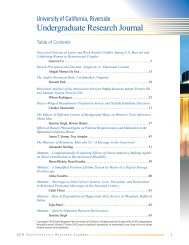UC Riverside Undergraduate Research Journal
UC Riverside Undergraduate Research Journal
UC Riverside Undergraduate Research Journal
Create successful ePaper yourself
Turn your PDF publications into a flip-book with our unique Google optimized e-Paper software.
Computational Prediction of Association Free Energies for the C3d-CR2 Complex and Comparison to Experimental Data<br />
Alexander S. Cheung<br />
magnitude of the excess charge in CR2 by 1e, a decrease<br />
in ΔΔG solvation is observed. Additionally, when a basic<br />
residue is mutated to an acidic residue, an even greater<br />
decrease in ΔΔG solvation is observed since such a mutation<br />
decreases the magnitude of the excess charge in CR2 by 2e.<br />
Intuitively, these results correlate well to those<br />
illustrated in Fig. 4A. In Fig. 4A, a proportional relationship<br />
is observed between ΔΔG solvation and association ability.<br />
In Fig. 5A,B, an increase in ΔΔG solvation was observed<br />
when the mutation increased the magnitude of the excess<br />
charge on the component (e.g. mutation of a basic amino<br />
acid to a neutral amino acid in C3d), while a decrease in<br />
ΔΔG solvation was observed when the mutation diminished<br />
the magnitude of the excess charge on the component (e.g.<br />
mutation of and acidic amino acid to a neutral amino acid in<br />
C3d). Because C3d and CR2 have opposite excess charge,<br />
an increase in the magnitude of the excess charge on<br />
either component can increase the long-range electrostatic<br />
attraction between the two components, speeding up<br />
formation of the encounter complex and thus ultimately<br />
resulting in an increase in binding ability.<br />
Similar plots have been generated in which the change<br />
in ΔΔG solvation is plotted against the distance between<br />
Arg390, the CR2 residue at the association site (not shown;<br />
data in Table 1). Trends similar to Fig. 5 were observed.<br />
Discussion<br />
The interaction of complement protein fragment C3d<br />
with the first two modules of CR2 has been the subject of<br />
many intensive studies among immunologists, because it is an<br />
essential link between innate and adaptive immunities. Earlier<br />
efforts by the Morikis Group have focused on shedding light<br />
on the underlying structural and physicochemical properties<br />
underlying C3d-CR2 association [3,5]. In particular, a twostep<br />
model was proposed according to which electrostatics<br />
drive the nonspecific recognition between C3d and CR2 and<br />
contribute to their specific binding. An earlier study by Zhang<br />
et al [5] presented calculations of ionization free energy<br />
differences as a function of pH, ionic strength, and mutations,<br />
which compared favorably with experimental data.<br />
In the present study, we examine the effect of<br />
solvation on the electrostatic free energies of association.<br />
We have calculated electrostatic free energies of association<br />
using two different methods. The first calculation<br />
produced a difference between electrostatic free energy of<br />
association and Coulombic free energy of association in<br />
vacuum, using the complete thermodynamic cycle of Fig.<br />
3, which incorporates solvation effects (vertical processes)<br />
in the calculation. The second calculation produced the<br />
electrostatic free energy of association in solution by using<br />
the bottom horizontal process only, which does not account<br />
for solvation. We have performed our calculations for the<br />
parent complex and the same mutants as in [5] for which<br />
there are published experimental association data [6,9]. We<br />
have demonstrated that the inclusion of solvation effects<br />
is necessary to accurately predict association abilities, by<br />
comparing our theoretical data to the experimental data.<br />
This is shown in Fig. 4 where a positive correlation is<br />
observed between the predicted solvation free energy<br />
differences and the experimental binding ability data (Fig.<br />
4A). In contrast, no correlation is observed when solvation<br />
effects are not taken into account (Fig. 4B).<br />
Moreover, we compare our calculated solvation free<br />
energy differences to the ionization free energy differences<br />
of Zhang et al [5] (Fig. 6). A solid correlation is observed<br />
between the two sets of data, with a correlation coefficient<br />
of -0.8. The negative sign indicates that solvation effects are<br />
unfavorable while ionization free energies are favorable.<br />
Inclusion of favorable Coulombic interactions (top horizontal<br />
process in the thermodynamic cycle) are expected to produce<br />
overall electrostatic free energies of association, which, when<br />
compared to the ionization free energy differences, will yield<br />
Figure 6. ΔΔG ionization versus ΔΔG solvation . ΔΔG ionization is from [5]. A<br />
linear fit is drawn in red.<br />
20 <strong>UC</strong>R Un d e r g r a d u a t e Re s e a r c h Jo u r n a l














